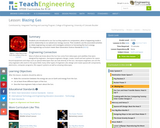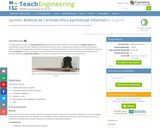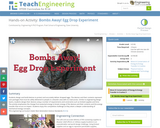
A Binary Code activity and worksheet for CS0 students. Part of the CUNY CS04All project.
- Material Type:
- Activity/Lab
- Provider:
- CUNY Academic Works
- Provider Set:
- College of Staten Island
- Author:
- Robert J Domanski
- Date Added:
- 03/19/2020

A Binary Code activity and worksheet for CS0 students. Part of the CUNY CS04All project.

Students act as if they are biological engineers following the steps of the engineering design process to design and create protein models to replace the defective proteins in a child’s body. Jumping off from a basic understanding of DNA and its transcription and translation processes, students learn about the many different proteins types and what happens if protein mutations occur. Then they focus on structural, transport and defense proteins during three challenges posed by the R&D; bio-engineering hypothetical scenario. Using common classroom supplies such as paper, tape and craft sticks, student pairs design, sketch, build, test and improve their own protein models to meet specific functional requirements: to strengthen bones (collagen), to capture oxygen molecules (hemoglobin) and to capture bacteria (antibody). By designing and testing physical models to accomplish certain functional requirements, students come to understand the relationship between protein structure and function. They graph and analyze the class data, then share and compare results across all teams to determine which models were the most successful. Includes a quiz, three worksheets and a reference sheet.

Students learn how to manipulate the behavior of water by using biochar—a soil amendment used to improve soil functions. As a fluid, water interacts with soil in a variety of ways. It may drain though a soil’s non-solid states, or its “pores”; lay above the soil; or move across cell membranes via osmosis. In this experiment, students solve the specific problem of standing water by researching, designing, and engineering solutions that enable water to drain faster. This activity is designed for students to explore how biochar helps soils to act as “sponges” in order to retain more water.

Students explore the biosphere's environments and ecosystems, learning along the way about the plants, animals, resources and natural cycles of our planet. Over the course of lessons 2-6, students use their growing understanding of various environments and the engineering design process to design and create their own model biodome ecosystems - exploring energy and nutrient flows, basic needs of plants and animals, and decomposers. Students learn about food chains and food webs. They are introduced to the roles of the water, carbon and nitrogen cycles. They test the effects of photosynthesis and transpiration. Students are introduced to animal classifications and interactions, including carnivore, herbivore, omnivore, predator and prey. They learn about biomimicry and how engineers often imitate nature in the design of new products. As everyday applications are interwoven into the lessons, students consider why a solid understanding of one's environment and the interdependence within ecosystems can inform the choices we make and the way we engineer our communities.

In this multi-day activity, students explore environments, ecosystems, energy flow and organism interactions by creating a scale model biodome, following the steps of the engineering design process. The Procedure section provides activity instructions for Biodomes unit, lessons 2-6, as students work through Parts 1-6 to develop their model biodome. Subjects include energy flow and food chains, basic needs of plants and animals, and the importance of decomposers. Students consider why a solid understanding of one's environment and the interdependence of an ecosystem can inform the choices we make and the way we engineer our own communities. This activity can be conducted as either a very structured or open-ended design.

This material is labwork meant to be used in conjunction with the Candela "Biology II" course.

Students examine the structure and function of the human eye, learning some amazing features about our eyes, which provide us with sight and an understanding of our surroundings. Students also learn about some common eye problems and the biomedical devices and medical procedures that resolve or help to lessen the effects of these vision deficiencies, including vision correction surgery.

Students use ultrasonic sensors and LEGO© MINDSTORMS© NXT robots to emulate how bats use echolocation to detect obstacles. They measure the robot's reaction times as it senses objects at two distances and with different sensor threshold values, and again after making adjustments to optimize its effectiveness. Like engineers, they gather and graph data to analyze a given design (from the tutorial) and make modifications to the sensor placement and/or threshold values in order to improve the robot's performance (iterative design). Students see how problem solving with biomimicry design is directly related to understanding and making observations of nature.

Students learn about biomimicry and how engineers often imitate nature in the design of innovative new products. They demonstrate their knowledge of biomimicry by practicing brainstorming and designing a new product based on what they know about animals and nature.

This lesson begins with a demonstration prompting students to consider how current generates a magnetic field and the direction of the field that is generated. Through formal lecture, students learn Biot-Savart's law in order to calculate, most simply, the magnetic field produced in the center of a circular current carrying loop. For applications, students find it is necessary to integrate the field produced over all small segments in an actual current carrying wire.

Students read news reports and first-person accounts to imagine what it would be like to be in a blackout in a large city. They follow news reports as if the event were unfolding in real-time and keep weblogs or journals of their experience as they imagine it, taking on different roles of people who live in the city or commute there to work. They use their journal accounts to create a play or screenplay that depicts what the August 2003 blackout was like for the people in the U.S. and Canada who experienced it. Although this activity is geared towards fifth-grade and older students, it could be easily adapted for younger students.

Rockets need a lot of thrust to get into space. In this lesson, students learn how rocket thrust is generated with propellant. The two types of propellants are discussed and relation to their use on rockets is investigated. Students learn why engineers need to know the different properties of propellants.

Students are introduced to our Sun as they explore its composition, what is happening inside it, its relationship to our planet (our energy source), and the ways engineers help us learn about it.

Students will make a proportional model of blood out of red gelatin, a plastic bag, and rice. They will learn about the different components that make up blood and will investigate what happens when the arteries and veins experience buildup from cholesterol. They will then work in pairs to brainstorm ways to clean our clogged arteries.

Students make a skydiver and parachute contraption to demonstrate how drag caused by air resistance slows the descent of skydivers as they travel back to Earth. Gravity pulls the skydiver toward the Earth, while the air trapped by the parachute provides an upward resisting force (drag) on the skydiver.

Using photographs and models, students are taken on a virtual journey to outer space. They can look back at the Earth as they travel further away and see it growing increasingly smaller, giving the experience that we live on a tiny planet that floats in a vast and empty space.

Los estudiantes diseñan, construyen y prueban vehículos de carreras hechos de bobinas de manualidades.

Students are introduced to the circulatory system, the heart, and blood flow in the human body. Through guided pre-reading, during-reading and post-reading activities, students learn about the circulatory system's parts, functions and disorders, as well as engineering medical solutions. By cultivating literacy practices as presented in this lesson, students can improve their scientific and technological literacy.

Students learn how engineers gather data and model motion using vectors. They learn about using motion-tracking tools to observe, record, and analyze vectors associated with the motion of their own bodies. They do this qualitatively and quantitatively by analyzing several examples of their own body motion. As a final presentation, student teams act as engineering consultants and propose the use of (free) ARK Mirror technology to help sports teams evaluate body mechanics. A pre/post quiz is provided.

Students design and build devices to protect and accurately deliver dropped eggs. The devices and their contents represent care packages that must be safely delivered to people in a disaster area with no road access. Similar to engineering design teams, students design their devices using a number of requirements and constraints such as limited supplies and time. The activity emphasizes the change from potential energy to kinetic energy of the devices and their contents and the energy transfer that occurs on impact. Students enjoy this competitive challenge as they attain a deeper understanding of mechanical energy concepts.